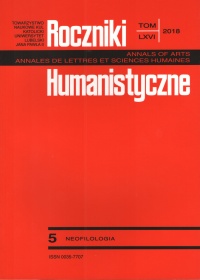Formal Demands and Semantic Shift in Translation of Soundtrack Lyrics
Abstract
The article undertakes an issue of semantic shifts in translation of soundtrack lyrics. In reference to the achievements of other linguists as Tidtford (1982) and Mayoral, Kelly, Gallardo (1988) the author stresses the specificity of the corpus translation and she criticizes a traditional textual approach in description of the subject. At the same time, she points out a contrariety between the pragmatic and communicative theory and the practice of translation. Through the contrastive analysis of the songs issued from four language versions of ten movies she attempts to reveal the lack of an obvious connection between the structural-semantic fidelity of translation and the necessity of synchronizing the communication systems. In order to raise the general mechanisms, she postulates parallel researches of the corpus, both oral and written (dubbing vs subtitling) and the variegation of source universes. Finally, she signalizes the primary role of the translator, his knowledge and capacities in the process of a translate’s autonomization.
References
Three Musicals by Benny Andersson and Björn Ulvaeus. Södertörns University. 2009.
CCAE = Corpus of Contemporary American English. Consulté le 12 décembre 2017, https://corpus.byu.edu/coca.
Dąbek, Karolina. « Music translation: “A song has to possess lyrics” — A hard nut to crack ». Polyglot’s Corner. This is the Modern Polyglots’ Blog. Consulté le 6 novembre 2017. https://polyglotscorner.wordpress.com/2017/08/03/music-translation-a-song-has-to-possess-lyrics-a-hard-nut-to-crack/.
Dąbek, Karolina. « Mécanismes du comique dans les textes originaux et dans la traduction. Cas des dessins animés américains en quelques langues choisies ». Sans publication. 2016.
Franzon, Johan. « Choices in Song Translation: Singability in Print, Subtitles and Sung Performance ». The Translator : Translation and Music 14 (2008), 2: 373–399.
Franzon, Johan. « Musical Comedy Translation: Fidelity and Format in the Scandinavian My Fair Lady ». Dans Song and Significance: Virtues and Vices of Vocal Translation. Réd. Dinda L. Gorlée, 263–297. Amsterdam, New York : Rodopi, 2005.
Franzon, Johan. My Fair Lady på skandinaviska: En studie i funktionell sångöversättning. Helsingfors : Helsingfors Universitet, 2009.
Gorlée, Dinda. L. « Prelude and Acknowledgements ». Dans Song and Significance : Virtues and Vices of Vocal Translation. Réd. Dinda L. Gorlée, 7–15. Amsterdam, New York : Rodopi, 2005.
Hurtado Albir, Amparo. Traducción y traductología. Madrid : Cátedra, 2001.
Lefevere, André. Translation. History. Culture. London : Routledge, 1992.
Leuven-Zwart, Kitty M. van. « Translation and original : Similarities and dissimilarities. I ». Target 1989, no 1(2): 151–181.
Low, Peter. « The Pentathlon Approach to Translating Songs ». Dans Song and Significance: Virtues and Vices of Vocal Translation. Réd. Dinda L. Gorlée, 185–212. Amsterdam, New York : Rodopi, 2005.
Low, Peter. « Translating poetic songs. An attempt at a functional account of strategies ». Target 15 (2003), 1 : 91–110.
Mayoral, Roberto, Dorothy Kelly, et Natividad Gallardo. « Concept of constrained translation : non-linguistic perspectives of translation ». Meta 33 (1988), 3 : 356–367.
NKJP = Narodowy Korpus Języka Polskiego. Consulté 12 décembre 2017. http://www.nkjp.uni.lodz.pl/.
Pezza Cintrão, Heloísa. « Translating Under the Sign of Invention : Gilberto Gil’s Song Lyric Translation ». Meta 54 (2009), 4 : 643–890.
Reiss, Katharina, et Hans J. Vermeer. Grundlegung einer allgemeinen Translationstheorie. Tübingen : Niemeyer. 1984.
Susam-Sarajeva, Şebnem. « Translation and Music : Changing Perspectives, Frameworks and Significance ». The Translator : Translation and Music 14 (2008), 2 : 187–200.
Titford, Christopher. « Sub-titling — Constrained Translation ». Lebende Sprachen. 27 (1982), 3 : 113–116.
Venuti, Lawrence. The Translator’s Invisibility. A history of translation. London, New York : Routledge, 1995.
Copyright (c) 2018 Roczniki Humanistyczne

This work is licensed under a Creative Commons Attribution-NonCommercial-NoDerivatives 4.0 International License.





